2764
Views & Citations1764
Likes & Shares
INTRODUCTION
Prediabetes is considered an intermediate stage leading to diabetes because there are no signs of recognition, the development is silent, often confusing with some other common diseases [1]. If pre-diabetic patients have early and appropriate interventions for cardiovascular risk factors and plasma glucose it can delay or even prevent the onset of diabetes [2,3]. Elderly people with high blood pressure associated with diabetes and/or pre-diabetes increase the risk of cardiovascular complications and mortality. Therefore, early detection of hypertensive elderly in Vietnam with pre-diabetes and risk factors for pre-diabetes is very important and necessary in clinical practice in the real world.
Therefore, we conducted the study "Surveying the prevalence of pre-diabetes and some risk factors in the elderly with hypertension in outpatient department at the clinic of District 1 hospital.” with 2 objectives:
- Determine the rate of pre-diabetes and the rate of dysglycemia in elderly hypertensive patients
- Identification of some risk factors for pre-diabetes in hypertensive elderly
SUBJECTS: RESEARCH METHODS
Study design: A prospective cross-sectional description.
Study population: All elderly patients (≥ 60 years of age) with a history of hypertension or currently meeting the criteria for a diagnosis of hypertension, being treated at outpatient department of District 1 hospital's clinic, have never been diagnosed with diabetes Type 2 before during the study period from September 2020 to June 2021
Inclusion Criteria:
Age ≥ 60 years old, agree to participate in the study and meet the following criteria:
- Meet the criteria for diagnosis of hypertension according to WHO/ISH guidelines 2003 and the Ministry of Health in Vietnam, issued in 2019.
- Complete tests for serum lipids, fasting plasma glucose and/or impaired plasma glucose tolerance test, HbA1c.
- Do not have diabetes or are being treated as diabetes type 2.
Exclusion Criteria:
- Patient did not agree to participate in the study
- Patient has a history of diabetes or is being treated for diabetes.
- Patients with severe renal impairment, severe liver failure or severe infection.
Data processing and analysis:
The data were entered and processed using the statistical software SPSS 22.
RESEARCH RESULTS
We recruited all elderly patients (≥ 60 years old) with hypertension who were treated at the clinic of District 1 hospital from September 2020 to June 2021, in which 361 cases met the admission criteria. All patients were done physical examination, blood tests and plasma glucose tolerant test. All records have the following results.
Demographic characteristics of the study population
The group of patients aged 60-69 years old accounted for the highest proportion with 56%, male accounted for 31.3%, family history of diabetes accounted for 27.4%; patients with smoking, or drinking alcohol have small proportion; the ratio of big waist/hips, big waist circumference and overweight/obesity is 70.4%, 30.5%, 55.1%, respectively. The rate of reduced mobility lifestyle is only 1/5 of the research population (Table 1).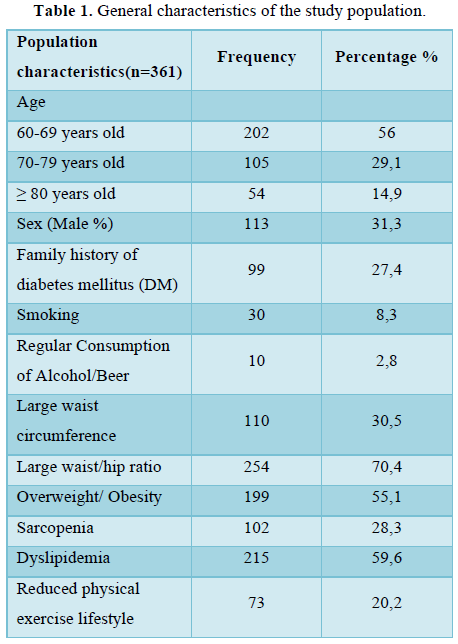
Characteristics of blood sugar of the study population
The highest fasting blood sugar was higher than the threshold for pre-diabetes (6.92 mmol/L) and had an average reading of 5.51 ± 0.58 mmol/L; The plasma glucose value 2 hours after the 75g glucose tolerance test had the highest value exceeding the threshold for diagnosis of new-onset diabetes (specifically, 21 mmol/L), the lowest value was 4.08 mmol/L and has an average value of 9.78 ± 3.37 mmol/L. The average value of HbA1c of the study population was 5.8 ± 0.72%, the highest HbA1c index was very high with 12.36% (Table 2).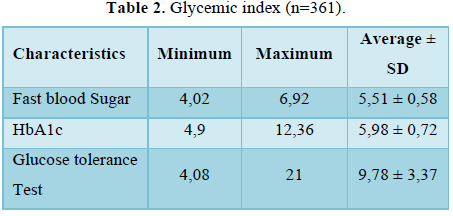
Prevalence of prediabetes and rates of dysglycemia
Through analyzing data from the screening study, we recorded that there were 40 elderly hypertensive patients who met the criteria for diagnosis of new onset diabetes type 2 with the prevalence of 11%. According to the ADA 2019 pre-diabetes diagnostic criteria, we recorded that 93 patients in the study were pre-diabetic, accounting for ¼ of the study population (25.8%). The proportion of elderly hypertensive patients with normal blood sugar in the study was 63.2% (Figure 1).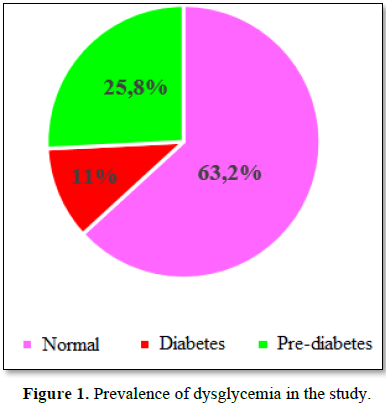
Subgroups of dysglycemia in pre-diabetic patients (n=93)
In the group of pre-diabetic patients, the group with the highest prevalence (37.62%), is the group having combination of 3 types of dysglycemia (fasting plasma glucose disturbances, impaired plasma glucose tolerance test and increased HbA1c). followed by the group having combined fasting plasma glucose disturbances and increased HbA1c with 24 patients, accounting for 25.81% of the pre-diabetic population, and the group with increased HbA1c alone accounted for 7.53% (Table 3).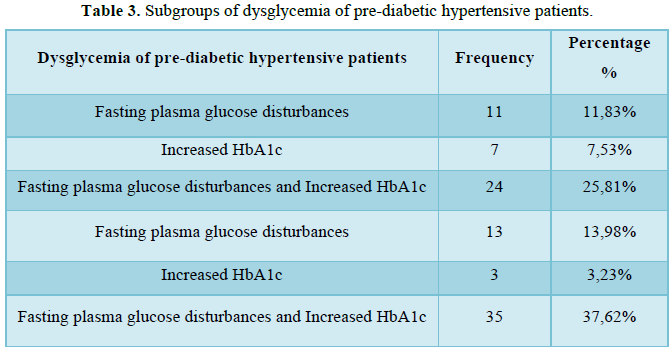
The relationship of cardiovascular factors and pre-diabetes
Through multivariable logistic regression analysis, we found that: Family history of diabetes is a risk factor that increases pre-diabetes 2.44 times when compared with the other individuals in the study with OR=2,44, CI 95% 1,43 - 4,17 (p<0.05). In addition, pre-diabetes increased in the sedentary group with odd ratio (OR) = 1.90; 95% CI 1.02 - 3.55 with p=0.04. Specifically, inactive, reduced physical exercise individuals had an increased risk of pre-diabetes is 1.9 times higher than in active individual. Other factors: big/large waist circumference, big/large waist-to-hip ratio, overweight, and obesity were not associated with prediabetes risk factors (Table 4).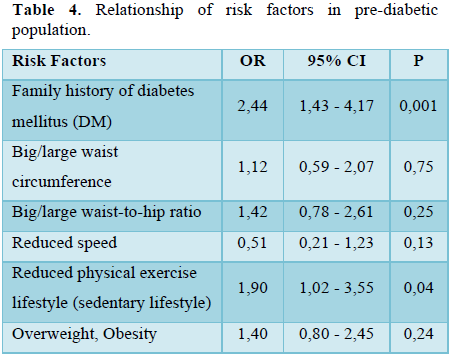
Characteristics of blood sugar of the study population
The results of study about prevalence of pre-diabetes in the elderly population are similar to the results of several domestic and foreign studies. Specifically, a study by author Wang [8] on the prevalence of pre-diabetes and related risk factors in adults in China recorded prevalence of pre-diabetes, new onset diabetes type 2 is of 27.25%, 5.7% respectively [8]. The results are similar to the results of our study with prevalence of pre-diabetes, new onset diabetes 25, 6%, 11%, respectively.
The relationship between prediabetes and some risk factors
Family history of diabetes is associated with pre-diabetes rates recorded in our study results with a statistically significant difference with p=0.02. The percentage of patients with a family history of diabetes increased in the group with pre-diabetes compared with the group having normal plasma glucose. The results of this study are similar to some studies by Lanh [9], Hu [10] in the medical literature [11].
CONCLUSION
From September 2020 to June 2021 at the outpatient clinic of District 1 Hospital, HCMC, through statistical analysis of 361 elderly patients with hypertension, we recorded: Pre-diabetes rate 25.8%, diabetes rate 11%. Family history of diabetes, and reduced physical activity lifestyle are two risk factors that respectively increase the risk of new-onset prediabetes with OR of 2.44; 95% CI:1.43- 4.1 (p=0.001) and 1.9 95% CI: 1.02-3.55 (p=0.04).
- Khanh TQ (2021) Clinical endocrinology. Medical Publisher.
- Tạ Văn B (2017) Living well with diabetes. J Diabetes pp: 30.
- Wang H, Liu T, Qiu Q, Ding P, He Y-H, et al. (2015) A Simple Risk Score for Identifying Individuals with Impaired Fasting Glucose in the Southern Chinese Population. Int J Environ Res Public Health 12(2): 1237-1252.
- Nguyen TTT, Ngo HH, Nguyen TD, Nguyen TPM, Pham VB (2018) Evaluating changes in knowledge of adherence to hypertension treatment of elderly people at Bac Ninh General Hospital in 2018. J Nurs Sci 1(2): 15-22.
- Zhuang Q, Wu L, Lu Y, Du J, Guo G (2015) Awareness and intervention status of prediabetes among Chinese adults: Implications from a community-based investigation. Int J Clin Exp Med 8(3): 4480-4486.
- Phuong CM, Le NV, Xuan HM (2013) Study on the prevalence of hypertension and its association with some risk factors in people aged 40 years and older in Tra Vinh province in 2012. J Cardiol Vietn 65: 1-7.
- Zhang X, Liu J, Shao S, Yang Y, Qi D, et al. (2021) Sex Differences in the Prevalence of and Risk Factors for Abnormal Glucose Regulation in Adults Aged 50 Years or Older With Normal Fasting Plasma Glucose Levels. Front Endocrinol (Lausanne) 11: 531796.
- Wang R, Zhang P, Zhijun, Lv X, Cai H, et al. (2019) The prevalence of pre-diabetes and diabetes and their associated factors in Northeast China: A cross-sectional study. Sci Rep 9(1): 2513.
- Lanh NV, Tap NV (2013) Diabetes situation and some related factors in Khmer ethnic group aged 45 years and over in Hau Giang province. J Prev Med 23(6): 142.
- Hu Z, Gao F, Qin L, Yang Y, Xu H (2019) A Case-Control Study on Risk Factors and Their Interactions with Prediabetes among the Elderly in Rural Communities of Yiyang City, Hunan Province. J Diabetes Res 2019: 1386048.
- Chen CL, Huang JY, Lin L, Yu YL, Shen G, et al. (2020) Relationship between diastolic blood pressure and the first ischemic stroke in elderly patients with hypertension. Postgrad Med J 96(1139): 525-529.
QUICK LINKS
- SUBMIT MANUSCRIPT
- RECOMMEND THE JOURNAL
-
SUBSCRIBE FOR ALERTS
RELATED JOURNALS
- Chemotherapy Research Journal (ISSN:2642-0236)
- Journal of Cancer Science and Treatment (ISSN:2641-7472)
- Journal of Oral Health and Dentistry (ISSN: 2638-499X)
- Journal of Neurosurgery Imaging and Techniques (ISSN:2473-1943)
- Journal of Otolaryngology and Neurotology Research(ISSN:2641-6956)
- International Journal of Medical and Clinical Imaging (ISSN:2573-1084)
- Journal of Blood Transfusions and Diseases (ISSN:2641-4023)


